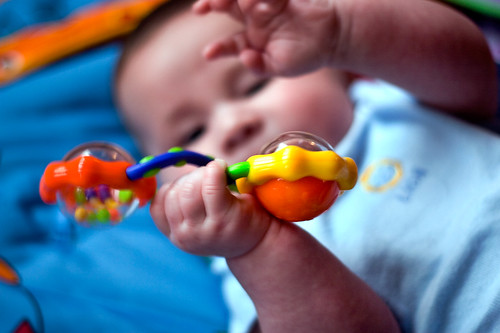An intriguing new study claims that clear behavioral symptoms of autistic spectrum disorders may be detected within a child’s first year of life and that they may be personified by the most innocuous of practices. Its largest conclusion: autistic children often play with simple toys in unusual ways that may provide clear evidence of emerging autistic spectrum disorders (ASD).
A study conducted at the acclaimed M.I.N.D. research institute at UC Davis involved 66 1-year-old infants, most of whom were deemed to be at a higher risk of developing autism due to at least once instance of ASD in their immediate families. They were each given four very simple toys (a rattle, a bottle, a metal lid and a plastic ring) and left to play with each object for approximately 30 seconds while cameras recorded their actions and researchers coded their behaviors. All the children involved were then scanned for autism at 36 months; researchers returned to the videos after receiving the results of these screenings to determine whether certain behaviors corresponded with later diagnoses.

The subject group was indeed predisposed to the development of ASD’s: 9 were diagnosed with autism at 3 years of age. On reviewing the video data, researchers noted that 7 of the 9 affected subjects appeared more actively obsessed with the objects themselves and engaged in unusually repetitive behaviors that were not observed in unaffected members of the subject pool. They spent lengthy periods staring intently at the shapes or looking at them from unusual angles (out of the corners of their eyes, etc.) and they each devoted a great deal of energy to moving and arranging the toys in very repetitive ways (spinning, rotating and rolling them back and forth, for example).
An obsession with simple objects, numbers and repeating patterns (often occurring at the expense of crucial social skills) is a trait common to the majority of autistic spectrum disorder patients. Delays in language usage and an apparent disinterest in or refusal to acknowledge other people are also near-universal symptoms. Compulsively repetitive behaviors may occur in nearly all circumstances. The fact that researchers only observed these symptoms in autistic children means that parents and professionals can begin to observe behavioral signs of autism at a very young age. While repeated patterns of play do not constitute a full diagnosis, concerned parents can watch their children carefully in order to determine whether their suspected conditions merit a professional opinion.
The importance of early diagnosis has been repeated again and again by those close to the subject. By the age of 3 or 4, many of autism’s most conspicuous behavioral symptoms have become well-ingrained in affected children. The sooner they can be diagnosed the sooner they can be treated and placed in special education classes. While most autistic children are not diagnosed until age 3 or older, at least one-third of affected parents notice symptoms before their child’s first birthday. That number should only increase as parents grow more sensitive in the face of developing research. This study could, most significantly, lead to expanded and more efficient early screening tests for autism. These tests now focus almost exclusively on social and communicative behaviors, but the study makes clear the fact that autism can be clearly observed even before children have the social capacity to respond to others.